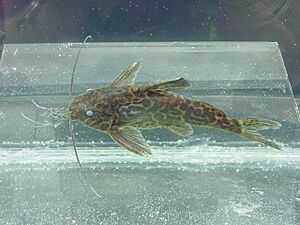Synodontis schoutedeni facts for kids
Quick facts for kids Synodontis schoutedeni |
|
|---|---|
 |
|
| Conservation status | |
| Scientific classification | |
| Genus: |
Synodontis
|
| Species: |
schoutedeni
|
The Synodontis schoutedeni, also called the yellow marbled Synodontis, is a special type of upside-down catfish. It lives in the Congo Basin in countries like the Democratic Republic of the Congo and the Republic of the Congo. This fish got its name from a Belgian scientist, Lore Rose David, who first described it in 1936. She found a special first example of the fish in a place called Basongo. The name "schoutedeni" honors another Belgian scientist, Henri Schouteden.
Contents
What Does the Yellow Marbled Synodontis Look Like?
This fish has a creamy body color. It also has a brownish-purple swirly pattern, like marble, on its head, body, and a small fin called the adipose fin. Its other fins are clear but have dark spots. As the fish gets older, these patterns often become even clearer and brighter.
Special Body Parts of the Synodontis Catfish
Like other fish in its family, the yellow marbled Synodontis has some unique features. It has a bony spike called a humeral process. This spike is connected to a hard cap on its head and sticks out past its gill opening. The first ray, or spine, of its dorsal fin (the one on its back) and its pectoral fins (the ones near its gills) are hard and have jagged edges. Its tail fin is forked, meaning it splits into two points.
This catfish has two types of teeth. In its upper jaw, the teeth are short and shaped like cones. In its lower jaw, the teeth are S-shaped and can move. It also has long, dark whiskers, called barbels, around its mouth. One pair of these barbels can reach all the way to its belly fins. It has two more pairs of barbels on its lower jaw, and these often have branches. The spine on its pectoral fin has small jagged edges on the outside and very rough edges on the inside.
How Big Does This Catfish Get?
The yellow marbled Synodontis usually grows to about 12.7 centimeters (5 inches) long. However, some have been found in the wild that are even bigger, reaching up to 17.1 centimeters (6.7 inches) in total length.
Where Does the Yellow Marbled Synodontis Live?
In the wild, this fish prefers warm, tropical waters. The water temperature is usually between 22 and 26 degrees Celsius (72 to 79 degrees Fahrenheit). It likes water that is slightly acidic to neutral, with a pH between 6.0 and 7.5. It has been found in the central part of the Congo River basin and in a large lake-like area called Pool Malebo. People in these areas sometimes catch this fish for food.


